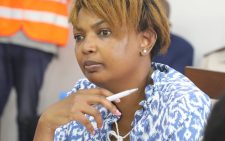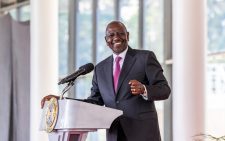Uhuru’s hits and misses as he exits office

President Uhuru Kenyatta today descends from the high office 3,444 days since he took over the nation’s leadership with gusto and hope after winning the 2013 election.
Today, as he hands over power to his successor William Ruto, Uhuru will look back at the 113 months in office that are a mixture of hits that would illuminate his heart, and misses he would hope would not haunt his legacy forever.
Uhuru took over the leadership mantle from the third President Mwai Kibaki at a time of uncertainty for himself as a person.
Facing a weighty case at the International Criminal Court following his indictment over the 2007 post-election violence, the President had to juggle between running the country and defending himself from crimes against humanity charges.
But just under two years after being sworn in on April 9, 2013, the President’s case was dropped after the court’s prosecutors said evidence before them had failed to satisfactorily link him to the crimes committed during the chaos.
It was a sigh of relief for the country’s fourth leader who got an opportunity to fully focus on leading the country even though his deputy William Ruto still had active case at the same Court. Ruto’s case was dropped in 2016, also for lack of evidence.
Relieved of the ICC burden, Uhuru retrained his focus and energy on delivering on the key promises he had made to the electorate.
During his last Madaraka Day on June 1 – his last public holiday speech as President – Uhuru said his government had made Kenya better.
“My administration has built on the gains secured by the previous three administrations and strengthened our social fabric, making Kenya safer and healthier; fairer and just nation where justice is truly our shield and defender; reinforced our educational and technical excellence; integrated devolution as a way of life; successfully led the nation through the worst global health crisis in a century; whilst also expanding economic opportunities for all Kenyans,” he said.
Hits
Infrastructure
On top of Uhuru’s agenda in the first term was realisation of the massive infrastructure projects including the multi-billion shillings Mombasa-Nairobi Standard Gauge Railway. The construction of the 480km railway started in 2013 and would cost Sh330 billion when it reached Nairobi in 2017.
Its extension to Naivasha, which was completed two years later, cost Sh150 billion.
Although it remains the biggest project that the Jubilee administration invested in, the SGR has attracted criticism from some quarters who cite its viability and alleged inflated costs.
But the President has consistently defended his decision to pump trillions into the railway and the other infrastructure projects, including the more than 10,000 kilometres of roads constructed by his administration.
“The naysayers said that we should not invest so heavily in infrastructure because people don’t eat roads and floating bridges. I refused their pessimism because I know what a new road means to the farmer who has for decades been unable to get their produce quickly to the market,” he said.
Devolution
Uhuru was the first President to oversee the implementation of the devolved system of government created by the 2010 Constitution.
The 47 counties came in place in 2013 and with them a governor for each county and an administration that looked upon the national government for billions in allocated funds.
Although the counties and the national government have disagreed on many issues, including delayed funds, the two levels have largely co-existed harmoniously.
To date, over Sh2.4 trillion has been dispersed to the counties although a huge chunk of it has been swallowed by recurrent expenditures.
Women leadership
Uhuru’s tenure has seen an increase in the number of women occupying senior positions in government.
He was the first to appoint women to occupy the powerful Foreign Affairs and Defence dockets. Among those who served in the positions are Amina Mohamed, Raychelle Omamo and Monica Juma.
Amina and Omamo were among the five women in Uhuru’s first Cabinet. Others were Phyllis Kandie (EAC Affairs, Labour), Charity Ngilu (Lands) and Anne Waiguru (Devolution).
It was during his rule that Kenya got its the first female Chief Justice, Martha Koome.
In Parliament, Joyce Laboso became the first woman to occupy the National Assembly’s deputy speakership in 2013. The same was replicated in the Senate in 2020 when Margaret Kamar was picked for a similar seat in the House.
Covid-19 Pandemic
President Uhuru steered the country through the world’s deadliest pandemic in over 100 years.
The coronavirus virus was first reported in the country in March 2020, a few months after its outbreak in China.
Although the Covid-19 had led to 5,600 deaths in the country by yesterday, the number remained low compared to other countries.
His government was, however, criticised for the stringent measures including the one-year long curfew, lockdowns, closure of bars and learning institutions and other restrictions meant to curb the spread of the disease.
Misses
Ballooning public debt
Uhuru’s administration leaves behind close to Sh10 trillion in public debt.
The debt shot up multiple times since 2013 due to the billions of money borrowed for infrastructure projects.
Terrorism
Nine months after taking over, the country witnessed one of the deadliest terrorist attacks as Al Shabaab militants staged a siege at Westgate Mall in Westlands, Nairobi in September 2013 killing 60 people and injuring hundreds of others.
The attack shook his young administration to the core although it would not take long before the worst happened. In April 2015, Al Shabaab killed at least 148 people, most of them students at Garissa University College.
Hundreds of lives were also lost in attacks on buses in Northern Kenya and other parts of the country.
Uhuru has, however, said his administration had successfuly clamped down on terror saying investment in the security sector had borne fruit.
“We silenced the wave of terror attacks that had a strangle hold on our Nation. We achieved this by retooling our security organs and making them more capable to address the dynamic contemporary security challenges that Kenya faces,” he said in his Madaraka Day speech.
Laptop Project
The Jubilee administration came to office with a high-flying promise to buy a laptop for each child joining primary school as part of its digitalisation agenda.
That would, however, fail following implementation challenges as the government struggled to ensure a smooth distribution of the gadgets.
CBC
Uhuru leaves office with uncertainty hanging over the future of the new 2-6-3-3-3 curriculum which critics say has been haphazardly implemented.
The Competency Based Curriculum (CBC) was gradually rolled out in 2019 to replace the 8-4-4 system.
But it has faced criticism for, among other reasons, being too demanding on learners and expensive on parents.
During the campaigns, Ruto said his administration would address the issues raised about the system if he won last month’s election.
Handshake/BBI
The Handshake between the President and his longtime nemesis Raila Odinga was meant to cease hostilities linked to the contentious 2017 elections.
Although it served the short-term objective of reducing the political temperatures, it failed to deliver its long-term objectives.
After the Handshake on March 9, 2018, the two aimed at bringing the country together through the BBI but it met fierce opposition from Ruto and his allies.
The Supreme Court hammered the last nail on the BBI coffin last March when it declared it unconstitutional.
The initiative aimed to, among other things, lead to a referendum on several proposed changes to the Constitution.







